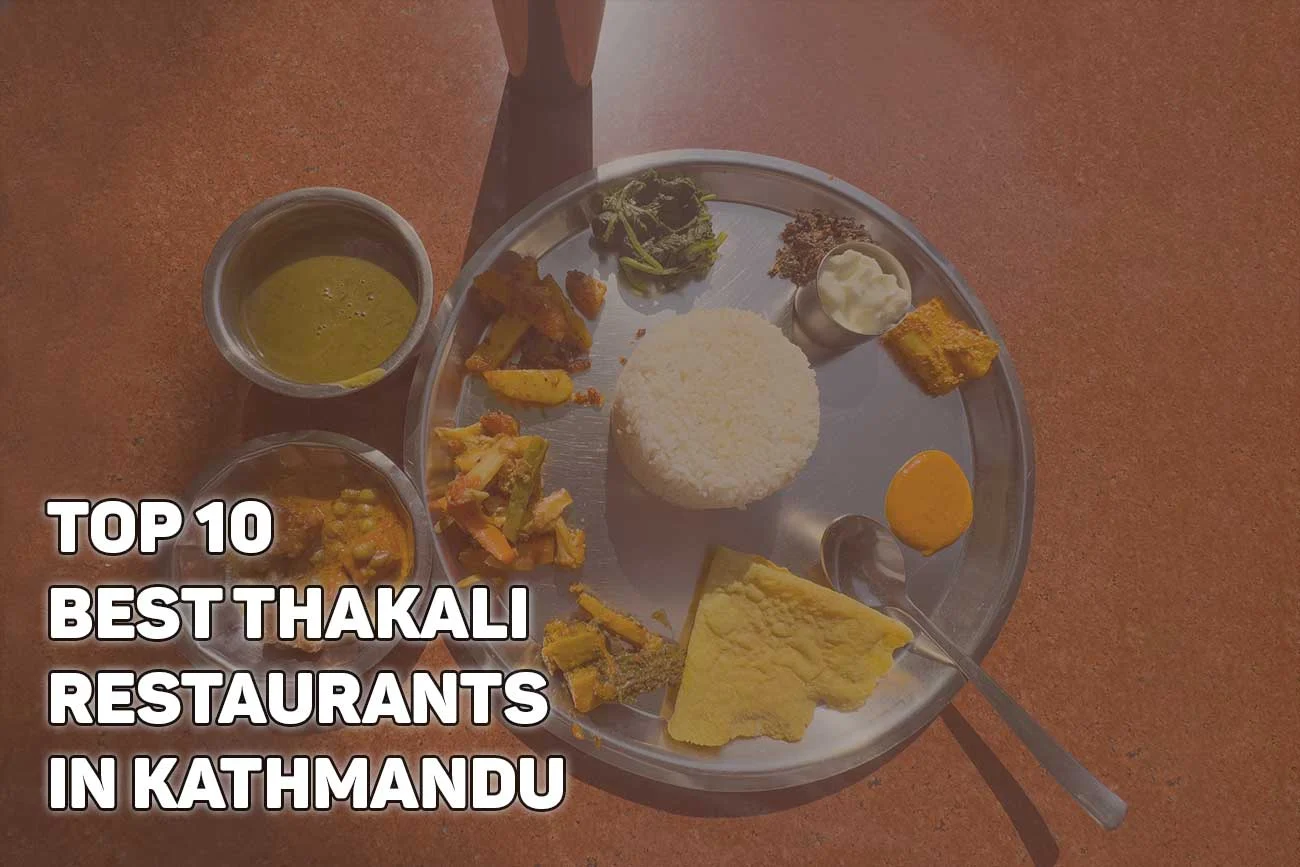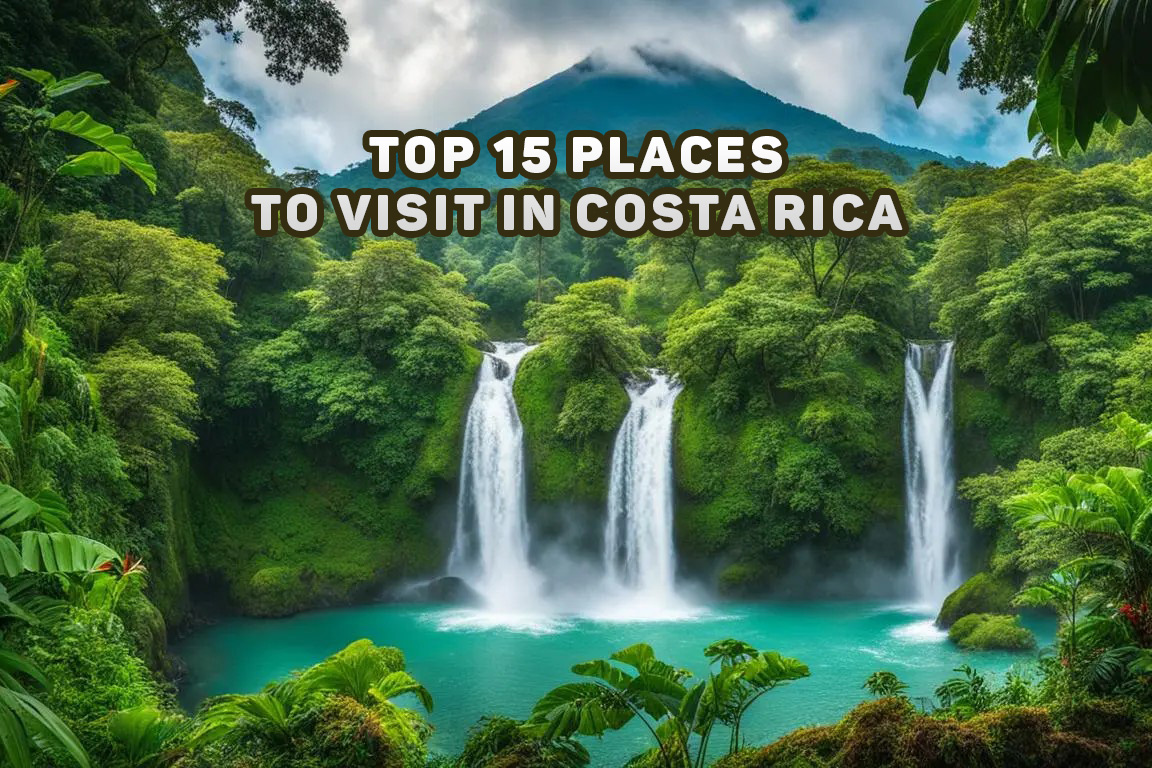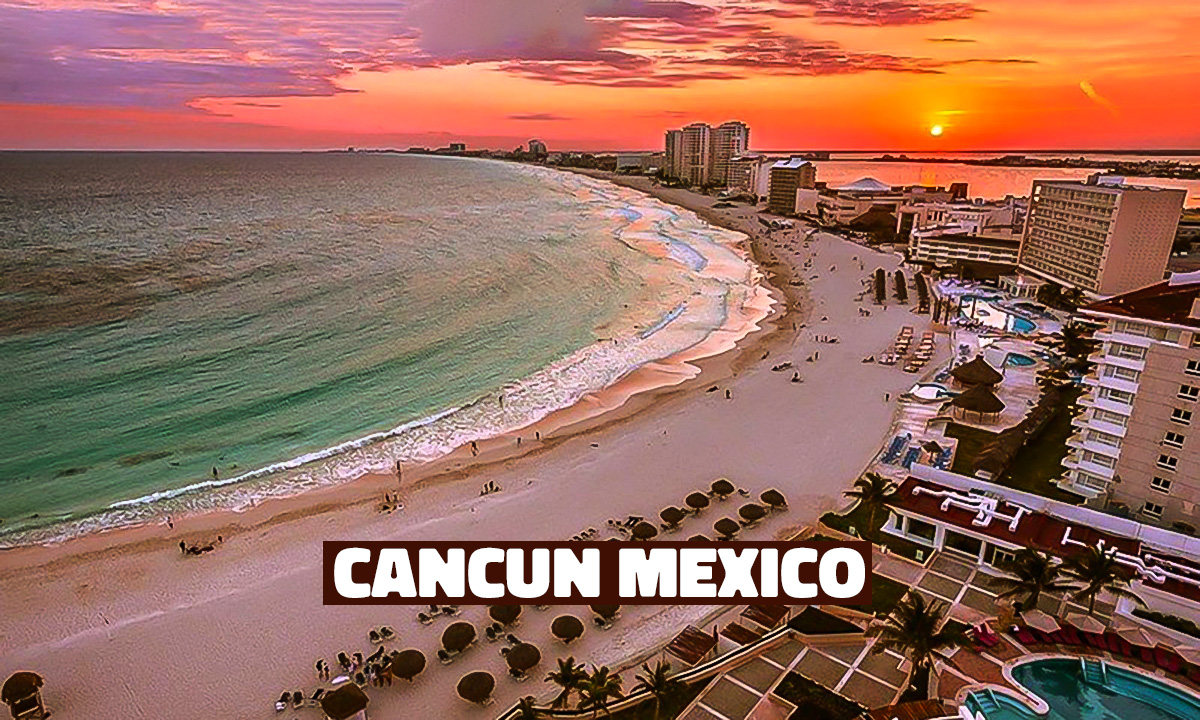Kathmandu is the capital city of Nepal and it is the largest metropolitan hub, inviting you with its vibrant heart and historic charm. in this article we will see top 10 must visit places in Kathmandu. This bustling city is part of the Kathmandu Valley, joined by two significant others, Patan, or Lalitpur, only a short 5KM trip southeast, and Bhaktapur, situated 14 KM to the east. Fondly, locals and tourists alike refer to Kathmandu as ‘KTM’.
Kathmandu is about 1,400 Meter above sea level, Kathmandu nestles in a valley shaped like a bowl, guarded by four towering mountains – Shivapuri, Phulchowki, Nagarjun, and Chandragiri. As of 2022, over 1.4 million people called this place home. Despite its urbanisation, the density remains surprisingly low, with the larger Kathmandu valley including its three districts being sparsely populated.
Known as the entrance to Nepalese tourism, Kathmandu serves as the country’s economic heartbeat. Boasting the most sophisticated urban infrastructure in Nepal, it relies heavily on tourism, contributing 6.7% of the nation’s GDP as of 2022.
Steeped in nearly 2000 years of rich history, Kathmandu is a colourful mosaic of different religions, with Hinduism and Buddhism taking the lead. This tapestry of faiths renders Kathmandu its unique cosmopolitan flavour. The city predominantly speaks Nepali, with Nepal Bhasa Newari also widely spoken due to its Newar inhabitants. English, too, is commonly understood among the educated populace.
An adventurer’s heaven, Nepal’s myriad attractions charm not just the mountain trekkers but other tourists as well. Kathmandu often surprises visitors who see beyond its apparent chaotic and polluted exterior. The city, housing several of Nepal’s 10 UNESCO World Heritage Sites, is brimming with unique discoveries. Despite its rough exterior, Kathmandu manages to captivate and delight with its cultural richness. The city is also a haven for food enthusiasts, boasting a wide variety of gastronomic delights.
Kathmandu, snuggled in a valley with mountains standing sentinel, is sure to leave an imprint on your heart. The slogan for Nepal Tourism, “Once is not enough,” rings true as the city continually uncovers hidden gems to visitors on repeated visits. Amid the Everest Base Camp Trek, Mustang Region, and Annapurna, each journey to Kathmandu introduces you to something previously unnoticed amidst its energetic streets.
Despite its hustle-bustle, Kathmandu retains an irresistible allure. The labyrinth-like lanes of Thamel, rickshaws winding through the streets, and the aroma of street food mixed with pollution might initially overwhelm. However, the richness of Nepal’s culture, celebrated in age-old traditions, offers an incredibly unique experience.
Here are below most popular tourist attraction in Kathmandu
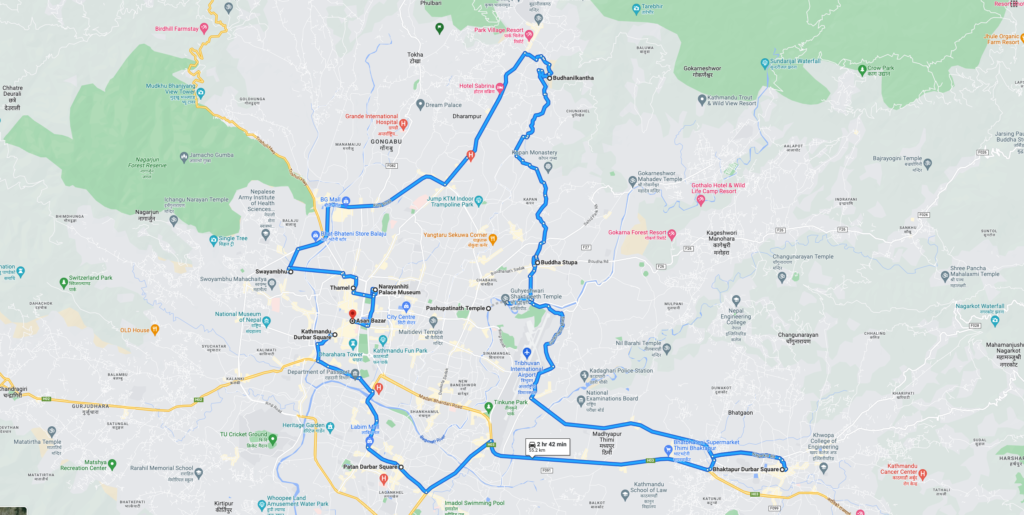
Table of Contents
Must Visit Places in Kathmandu
Here are my picks for the must visit places in Kathmandu, my opinion is based on Google reviews and personal experience.
1. Pashupatinath Temple
The Pashupatinath Temple is another top destination in Kathmandu. Recognized as a UNESCO World Heritage Site, it is among the holiest Hindu sites in Nepal.
Located on the banks of the Bagmati River, this is the largest temple complex in Nepal. Constructed in the 5th century and later renovated by the Malla Kings, the main temple in this complex is dedicated to Lord Shiva and is exclusively accessible to Hindus.
The temple complex offers an up-close view of Hindu cremation ceremonies on raised platforms along the river. Although this can be a disturbing sight for some, it provides a deep insight into the Hindu rituals surrounding life and death.
In the temple complex, be wary of painted saints, known as Sadhus, who demand money in exchange for photographs. If you wish to take their photos, you must be prepared to pay, or refrain from taking their pictures.
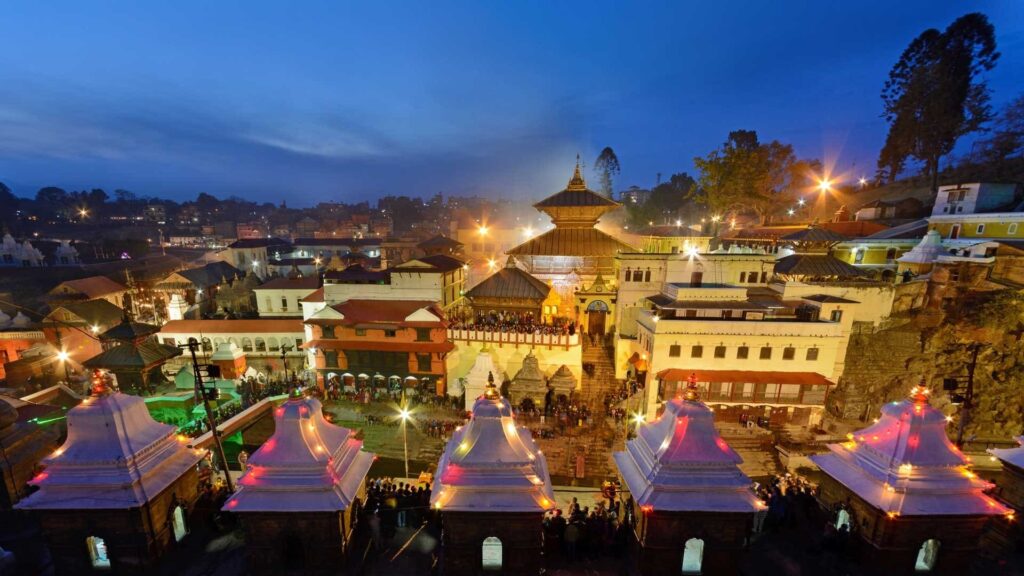
Pashupatinath is one of the seven UNESCO Cultural Heritage Sites in Kathmandu and is counted among the four most important religious sites in Asia for devotees of Shiva. This site offers a profound mix of religious, cultural, and spiritual experiences. Being the oldest Hindu temple in Nepal, dating back to the 5th century, it holds immense historical significance.
Within the complex, you’ll find the main Pashupatinath Temple and several smaller temples dedicated to various other Hindu and Buddhist deities. The temple complex is open from 4am to 9pm, but tourists are not permitted to enter the main Pashupatinath Temple. However, all the other temples are open for foreigners to explore.
Significance of Pashupatinath Temple:
Pashupatinath is the oldest known Hindu Temple in Kathmandu, showcasing various Hindu rituals in their pure spiritual form. It provides visitors with the unique opportunity to witness the Hindu culture’s deep-seated beliefs about life, death, and reincarnation. Believed to have existed since the inception of Hindu civilization, Pashupatinath holds a significant place in the hearts of Lord Shiva’s devotees.
Evening Aarati at Pashupatinath:
A mesmerizing sight at this temple is the Pashupati Aarati, a worship ritual performed by three priests who move oil lamps in a circular motion, dedicating the light from the wicks soaked in ghee (clarified butter) to God. This ritual starts at 6 pm every evening and is considered the highest form of prayer.
Getting to Pashupatinath Temple from Thamel:
It takes about 15 to 25 minutes to reach Pashupatinath from Thamel, depending on traffic. Taxis may overcharge, so it is advised to set a price before getting in. It should cost about 200 to 250 rupees. Bargaining is recommended.
2. The Kathmandu Durbar Square:
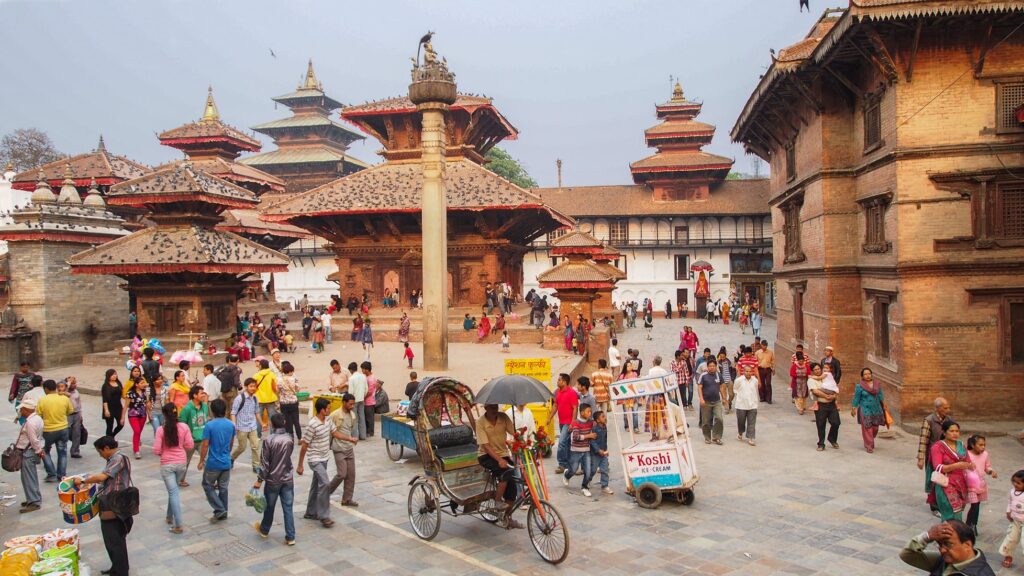
Kathmandu Durbar Square, a prominent city landmark, ranks among the city’s top tourist destinations. As the heart of the old city, this square was traditionally the site of the king’s coronation. As a UNESCO World Heritage Site, it is one of three such squares in the Kathmandu Valley.
From this palace, many of Nepal’s kings ruled. While the 2015 earthquake did bring down many of its temples, ongoing reconstruction efforts continue to ensure that the Durbar Square remains a must-visit destination in Kathmandu, despite the poignant sight of its tilted roofs and cracked palace.
Key Attractions at Durbar Square:
Kathmandu Durbar Square: Also known as Basantapur Durbar and Hanuman Dhoka, this square lies in the city centre. Intricate wood carvings and a rich history never fail to impress first-time visitors. The square hosts over 50 temples, several palaces, courtyards, and is often called “the Museum of Temples.” Around Gaddi Baithak, you’ll find handicraft shops selling attractive wares.
Taleju Temple: The tallest structure in the square, the Taleju Temple, was built by King Mahendra Malla in 1549 AD. Open to the public once a year during the Dashain festival, it offers a unique experience.
Kumari Temple: This 17th-century temple, home to the Living Goddess Kumari, showcases highly developed Nepali craftsmanship. Visitors can catch a glimpse of the living goddess and seek her blessings during special hours.
Jagannath Temple: Noted for the erotic figures carved on its wooden struts, this 16th-century temple has fascinated many visitors.
Nasal Chowk: A beautiful courtyard and your first stop within the royal residence. Nasal Chowk, built during the Malla dynasty, was used for coronations throughout the Rana regime.
Narsingha Statue: This stone image of Lord Vishnu in his man-lion avatar was erected by Pratap Malla in 1673.
Swet Bhairav: This Bhairav temple, a shrine to the avatar of Shiva, is only open once a year during the Indra Jatra festival.
Shisha Baithak: An open patio with the Malla throne on display and portraits of Shah kings.
Tribhuwan Museum: Memorials to Kings Mahendra and Birendra, as well as King Tribhuvan’s successful rebellion, can be found here. The museum showcases the king’s bedroom, study, and personal belongings, providing a surreal glimpse into his life.
Kal Bhairab: This is one of the largest 17th-century stone statues in Kathmandu, representing a terrifying aspect of Lord Shiva.
The ideal time to visit Durbar Square is in the early morning, before the crowds pour in. The Square is conveniently located just 1.6 km away from Thamel, making it easily accessible.
3. Patan Durbar Square
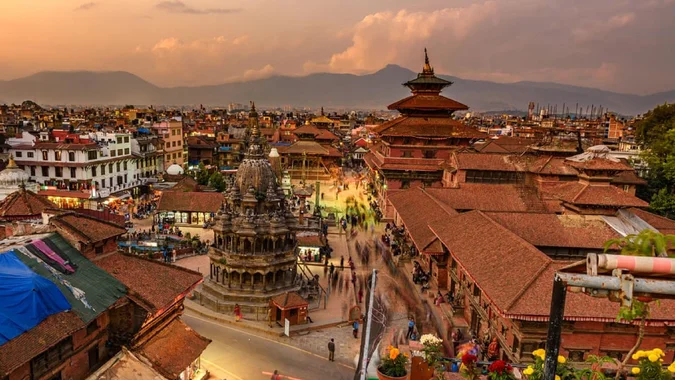
If you’re seeking a place that truly encapsulates the spirit and beauty of Kathmandu, look no further than Patan. Known traditionally as Lalitpur (City of Beauty), Patan is situated 5 km south of Kathmandu’s center and is renowned for its stunning architecture.
Patan is reputed to be the oldest town in the Kathmandu Valley, and it certainly lives up to this reputation with its remarkable collection of temples, palaces, and monuments. Locals also refer to Patan by its Newari name, Yala.
The city’s intricate Newari architecture, expansive palace courtyards, and meticulously detailed wood and stone carvings in its temples are nothing short of awe-inspiring.
Patan, or Lalitpur, is encircled by four stupas, each one constructed by Emperor Ashoka. The city’s Durbar Square is a hive of activity, brimming with locals and tourists alike at all times.
For any first-time visitor, a trip to Patan is a must. It is an architectural treasure, offering a wealth of historical and cultural insights.
Patan Durbar Square, renowned for its artistic heritage, is home to a myriad of temples dedicated to various deities. Located in the heart of Lalitpur and across the Bagmati River, the square is a bustling hub of cultural activity. Major attractions include the Hiranya Varna Mahavihar, Mahabouddha Temple, Patan Museum, and the Krishna Temple. Notably, the Krishna Temple is the only temple in Nepal boasting 21 shrines and made entirely of stone.
The Patan Durbar Square Museum is another notable attraction. Inaugurated by the late King Birendra Bir Bikram Shah in 1997, this museum specializes in bronze statues and religious artifacts. Set within the historic Durbar Square, it is renowned as one of the finest museums in Asia, featuring a vast collection of traditional sacred art and bronze statues.
How to Get to Patan Durbar Square from Thamel?
Reaching Patan from Thamel is relatively straightforward. You can take the central bus from Ratna Park, which drops you outside the main gate. The bus fare typically costs around 20 NPR, but foreigners may be charged 50 rupees. The journey takes about 30 to 45 minutes, depending on traffic and crowd conditions.
Alternatively, taking a taxi to Patan is a convenient option, though you might expect to pay around 500 rupees. Remember, bargaining can work in your favor here.
4. Bhaktapur Durbar Square
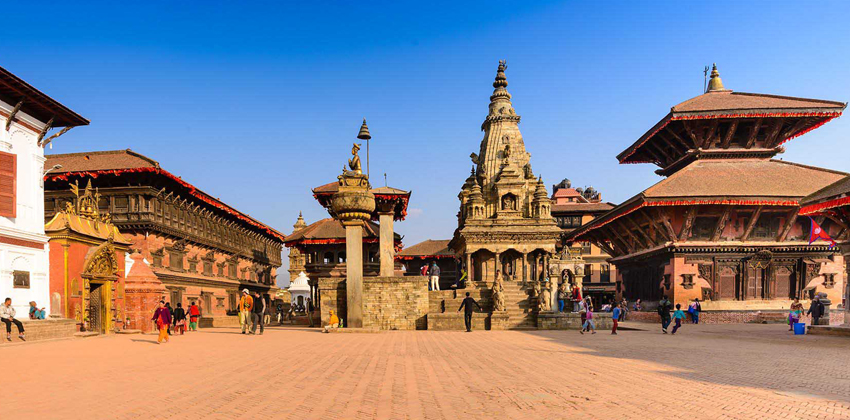
Bhaktapur, located 13 km from Kathmandu, is renowned as the city of temples, offering a unique blend of ancient heritage and towering temples. Bhaktapur Durbar Square, a UNESCO World Heritage Site, is an unmissable site, having survived the 2015 earthquake relatively unscathed compared to other areas of the Kathmandu Valley.
Bhaktapur Durbar Square is the royal palace’s ancient heart, sitting at an altitude of 1400m. Divided into four distinct areas: the Durbar area, Taumadhi area, Dattatreya area, and Pottery area, it is a major tourist attraction in the Kathmandu valley. This royal palace, which was once ruled by the Malla kings, is rich in history, culture, crafts, arts, and architecture.
Layout: The Bhaktapur Durbar Square is surrounded by a variety of lively architectural structures, temples, and idols, all of which embody the skill and craft of the Newari artists. The royal palace of the Malla kings was initially situated at Dattaray square, but it was later moved to Durbar Square. The design of this building, along with the surrounding temples like Taleju Bhawani and Temple (which are not allowed to be photographed), are sure to captivate visitors.
Main Attractions of Bhaktapur Durbar Square
Fifty-Five Windows Palace: This palace, also known as Pachpanjhaley Durbar, was initiated by King Bhupatindra Malla and completed during his son, Ranjit Malla’s reign in BS 1765.
Vatsalya Devi Temple: This temple, renowned for its large silver bells, is dedicated to the goddess Vatsalaya Devi. According to local lore, the dogs in the area begin to bark and howl when the temple’s large bell is rung. This bell, installed by Malla king Ranjit Malla in BS 1737, is rung every morning while worshipping Taleju Bhagwati.
Bhupatindra Malla’s Statue: Located on a column facing the palace, the statue of Bhupatindra Malla is considered one of the palace’s most enchanting features.
Nyatapola Temple: The term Nyatapola, derived from the Newari language, signifies ‘five stories’. This temple, regarded as the highest pagoda temple in Nepal, is dedicated to the goddess Siddhi Laxmi. Open only during the Dashain festival, it’s believed that the construction of this temple was completed across three generations.
Bhairavnath Temple: This temple is devoted to God Bhairav, regarded as a manifestation of Lord Shiva.
Golden Gate: Constructed by King Bhupatindra Malla, the Golden Gate is considered one of the world’s most magnificent and richly designed arts. The gate, decorated with Hindu monasteries and other distinct yet attractive creatures, is the entrance to the courtyard of the fifty-five palaces.
Lion’s Gate: This gate, crafted by artisans, became famous after the Bhadgaon king severed the artisans’ hands out of resentment upon its completion.
Mini Pashupati Temple: This temple, dedicated to Lord Shiva, was built as per the dream of the Bhadgaon King. It is similar to the Pasupathi Temple but is small in size.
In Bhaktapur, the past comes to life. Meandering through its narrow streets provides visitors with a unique opportunity to witness artisans at work and to experience traditional life in the City of Devotion. Top sights include the Nyatapola Temple, Taumadhi Square, and Dattatreya Temple. Make sure to immerse yourself in the local culture for an authentic experience.
5. Boudhanath Stupa
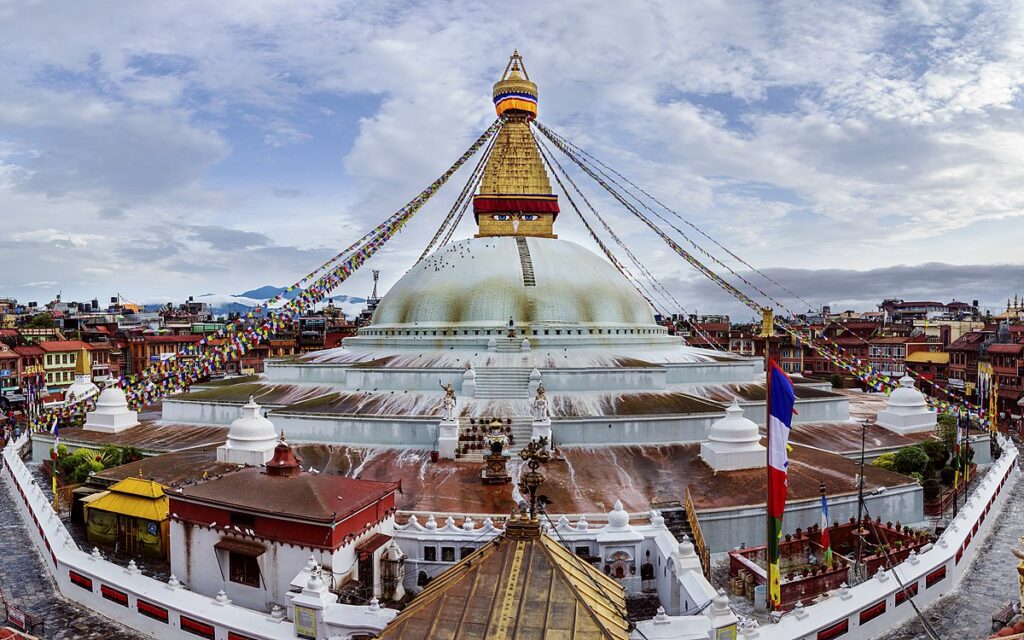
Also known as Buddha Stupa, Chorten Chempo, Chaitya, Jarung Khashor, and Khasti, is one of the most iconic landmarks in Kathmandu, Nepal. With a mammoth spherical shape that dominates the city’s skyline, this colossal dome is an emblematic center of faith for numerous pilgrims from different religions who gather here daily. They perform a ritualistic circumnavigation, known as the ‘kora’, around the dome, believing that anyone who completes this walk with a pure heart receives good karma.
Located approximately 11 kilometers from the city center of Kathmandu, Boudhanath Stupa is recognized as the largest stupa in Nepal and the entire continent. It received the honor of being listed as a UNESCO World Heritage Site in 1979. The stupa complex houses 50 Tibetan gompas or convents, which have sheltered Tibetan refugees since 1959. The stupa is believed to hold the remains of Kassapa Buddha.
Historically, the first stupa at Boudhanath was constructed sometime after AD 600 by the Tibetan king, Songtsen Gampo, after his conversion to Buddhism. The current stupa is a reconstruction, as the original was destroyed by Mughal invaders in the 14th century. Despite this, Boudhanath remains a perfect exemplification of grace and purity of design, from its whitewashed dome to its gilded tower painted with the all-seeing eyes of Buddha.
This stupa holds deep symbolic significance, representing Buddha’s path towards enlightenment. The plinth represents the earth, the Kumbha (dome) symbolizes water, the harmika (square tower) signifies fire, the spire represents air, and the umbrella at the top epitomizes the void or ether beyond space. The 13 levels of the spire signify the stages that a human being must traverse to achieve nirvana.
The stupa is rumoured to house holy relics; some claim that it contains relics of the past Buddha, Kashyapa, while others believe it holds a piece of bone from the skeleton of Siddhartha Gautama, the historical Buddha. Encircling the base of the stupa are 108 small depictions of the Dhyani Buddha Amitabha and a ring of prayer wheels set in groups of four or five into 147 niches.
Over centuries, the Boudhanath Stupa has served as a beacon of Buddhist belief. Constructed in the 14th century, it has attracted devotees due to its position on an ancient trade route. However, it truly became a centre of Tibetan Buddhism in the 1950s, as refugees from China began settling in Kathmandu and establishing temples around the stupa.
One of the stupa’s most distinctive features is the pairs of eyes painted on each side of the stupa’s tower, symbolizing the omniscience of Buddha. To visitors and worshippers alike, these eyes serve as a constant reminder of the enlightened vision and eternal vigilance of the Buddha. This adds to the serene and awe-inspiring ambience of this ancient and significant spiritual site.
6. Swayambhunath Stupa
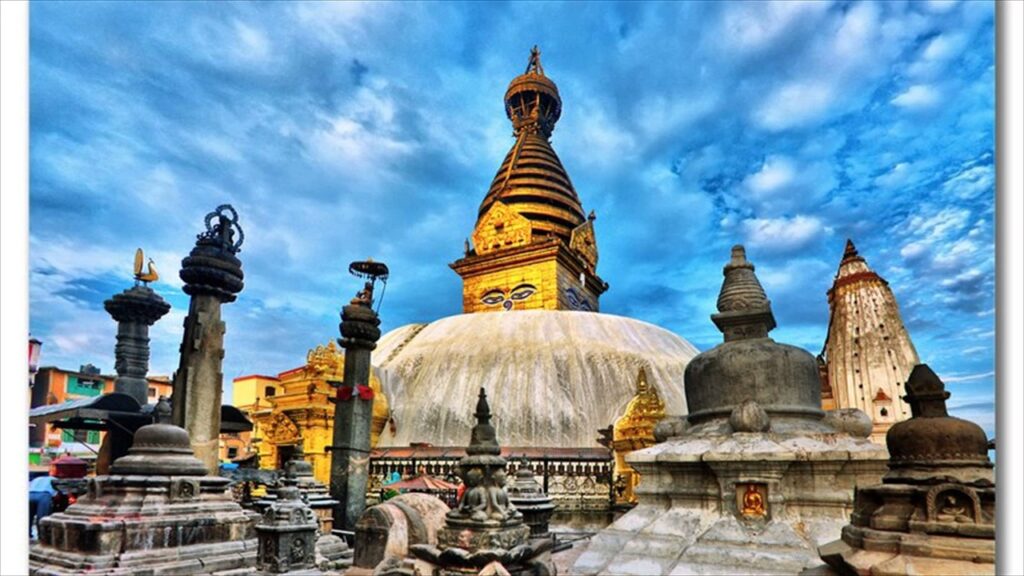
The Swayambhunath Stupa, one of Nepal’s oldest and most significant Buddhist World Heritage Sites, stands as a beacon of spiritual significance. This complex, boasting a grand stupa and a myriad of shrines and temples from over 1,500 years ago, is commonly referred to as the Monkey Temple, named for the tribes of monkeys that call it home. Although charming at a glance, visitors are advised to remain cautious as these monkeys can sometimes show aggression or attempt to pilfer belongings.
Perched on a towering hill in the Kathmandu Valley, about a 15-minute journey west of downtown Kathmandu, the Swayambhunath Stupa can only be accessed by ascending hundreds of steps. This climb may pose a challenge to those with mobility issues, so it’s best to plan your visit accordingly. However, your effort is rewarded with breathtaking panoramic vistas of the city and the sight of the captivating religious structures, affirming that every step taken was worth it.
A visit to Swayambhunath Stupa can be integrated into a UNESCO World Heritage Site Tour, where you’ll be able to explore four of Kathmandu’s major sites: Swayambhunath Stupa, Bouddhanath Stupa, Pashupathinath Temple, and Kathmandu Durbar Square. This tour not only immerses you in local history and culture but also allows you to savour the stunning views from the Swayambhunath Stupa.
The Swayambhunath Stupa, one of Kathmandu Valley’s oldest temples established around 460 AD, is known for its sweeping views of Kathmandu City. A haven for those seeking to experience Buddhist culture, it houses a diverse array of Buddhist statues and monuments.
Despite the 2015 earthquake, the main stupa of Swayambhunath remained largely unscathed. While the impressive stupa alone merits a visit, the site offers much more to see and appreciate.
While at Swayambhunath Stupa, be sure not to miss:
- The largest statue of Sakyamuni Buddha in Nepal.
- A temple dedicated to the Goddess of Learning.
- The massive gold-plated Vajra ‘thunderbolt’ is positioned on the stupa’s east side.
- The Sleeping Buddha.
- The Dewa Dharma Monastery.
These landmarks promise an enriching visit that goes beyond just a sightseeing tour, offering profound insights into Nepal’s rich cultural and spiritual heritage.
7. Narayanhiti Palace Museum
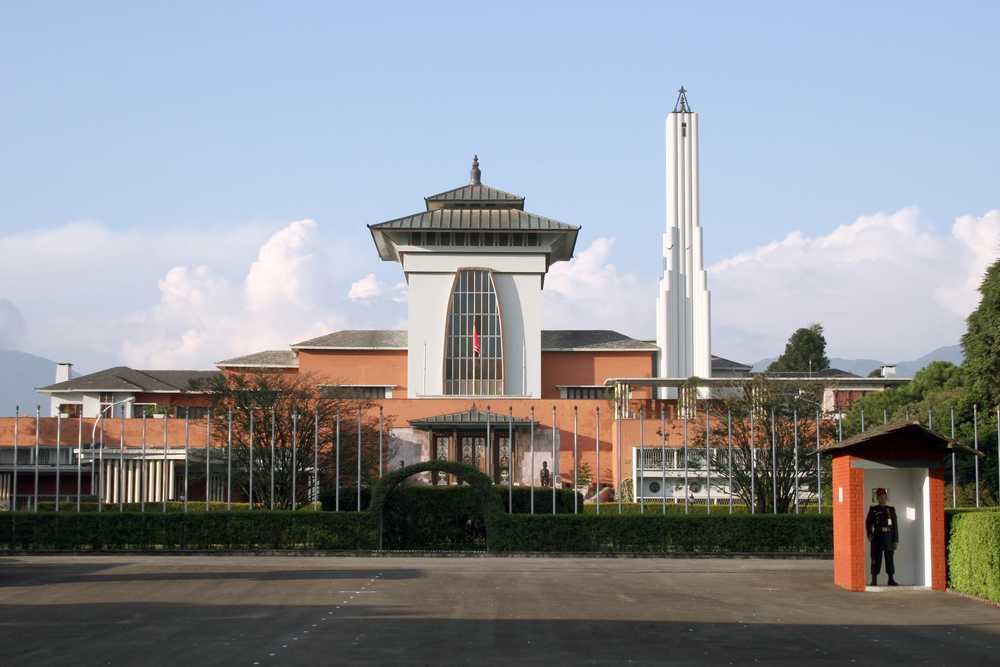
For those interested in history and culture, a visit to the Narayanhiti Palace Museum is a must. This former royal palace was the residence of King Gyanendra until he was expelled in 2008. After his departure, the palace was transformed into a museum for the public.
Visitors can explore the palace’s 52 rooms, each offering a unique glimpse into the lives of Nepal’s royalty.
The palace is located to the east of the renowned Kaiser Mahal near Thamel. It holds historical significance due to the tragic Royal Family Assassination of 2001. The museum showcases the grandeur of the royal lifestyle, with displays featuring the old furniture, artworks, and ornaments that once adorned the palace’s halls.
The palace’s name, Narayanhiti, is derived from two words: ‘Narayan,’ signifying the Hindu god ‘Lord Vishnu,’ and ‘Hiti,’ which means ‘water spout.’ This name is significant because of the temple of Lord Vishnu, located directly opposite the palace complex. Additionally, a water spout is found on the eastern side of the main entrance, adding to the relevance of the name. Over the years, Narayanhiti Palace has witnessed significant historical events.
Initially the royal residence of the Shah Kings of Nepal, the Narayanhiti Palace Museum was established by the late King Mahendra Bir Bikram Shah Dev in 1963. He and his successors resided in the Narayanhiti Royal Palace until 2008 when King Gyanendra, the last King of Nepal, was dethroned.
Once Nepal transitioned to a Federal Democratic Republic, King Gyanendra vacated the Narayanhiti Palace. Since then, it has ceased to be the royal residence and, for almost a decade, has been opened to the public as a museum. Visitors can purchase tickets at the entrance gate to explore this historic and fascinating structure.
The palace’s proximity to Thamel, a mere 750 meters away, makes it an easily accessible attraction for those staying in the area. The Narayanhiti Palace Museum offers a unique insight into Nepal’s royal history and heritage.
8. Budhanilkantha Temple
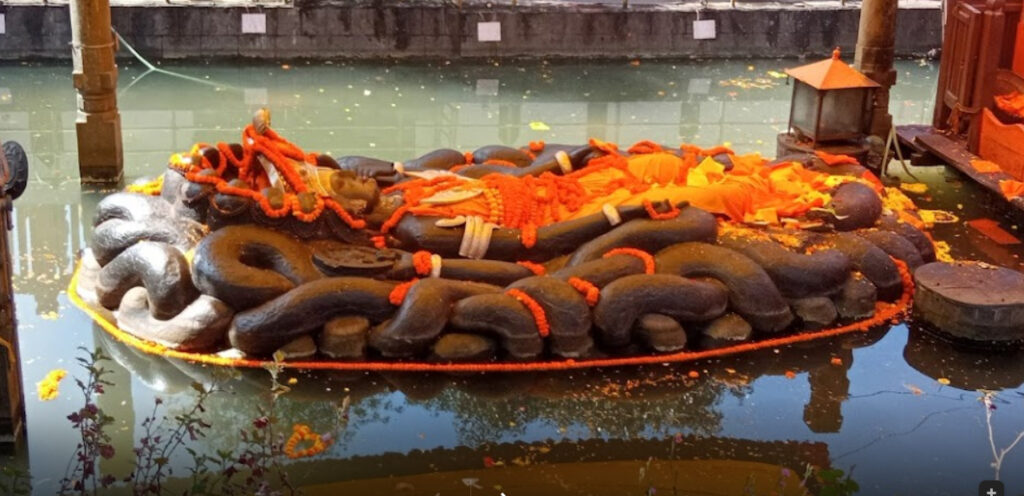
Resting at the foothills of the Shivapuri Hill, around 10 kilometres from the heart of Kathmandu, the Budhanilkantha Temple houses the grandest stone depiction of the Hindu deity, Vishnu, in all of Nepal. The temple’s name, Budhanilkantha, translates to “old blue-throat.” An oasis of tranquillity, this temple draws a steady stream of devotees and tourists alike, making it an essential stop on any Kathmandu itinerary.
History: The origins of Budhanilkantha Temple’s centerpiece – the magnificent Vishnu statue, have different interpretations. Some accounts suggest that during the 7th century, under Monarch Vishnugupta’s reign and during King Bhimarjun Dev’s rule over Kathmandu valley, forced labour or devotees painstakingly carved and transported the statue to its present location. Another popular folk tale talks of a farmer and his wife accidentally striking the deity while tilling their land, only to see blood flow from the ground. The subsequent discovery of the long-lost Budhanilkantha deity led to its restoration and placement in its rightful position. Despite the conflicting narratives, the reverence for the deity remains unchanged.
Attractions: Budhanilkantha Temple’s star attraction is undoubtedly the monumental statue of Vishnu, intricately carved from a single block of black basalt stone. Lying in a reclining pose, the statue stretches approximately five meters in length, nestled within a water tank about thirteen meters long. Known widely as the Sleeping Vishnu or Jalakshayan Narayan, the statue showcases the deity reclining on the serpent Shesha’s coiled body.
Vishnu’s legs are crossed, and Shesha, considered a loyal servant of Lord Vishnu, forms a makeshift cradle with its eleven heads. The deity’s four hands clutch symbolic objects representing his divine powers: a chakra or disc signifying his intellect, a conch shell representing the four elements, a lotus flower symbolizing the moving universe, and a club embodying primaeval knowledge. The temple’s fascinating details and the grandeur of the statue make a visit to Budhanilkantha a unique spiritual journey.
9. Thamel Bazar
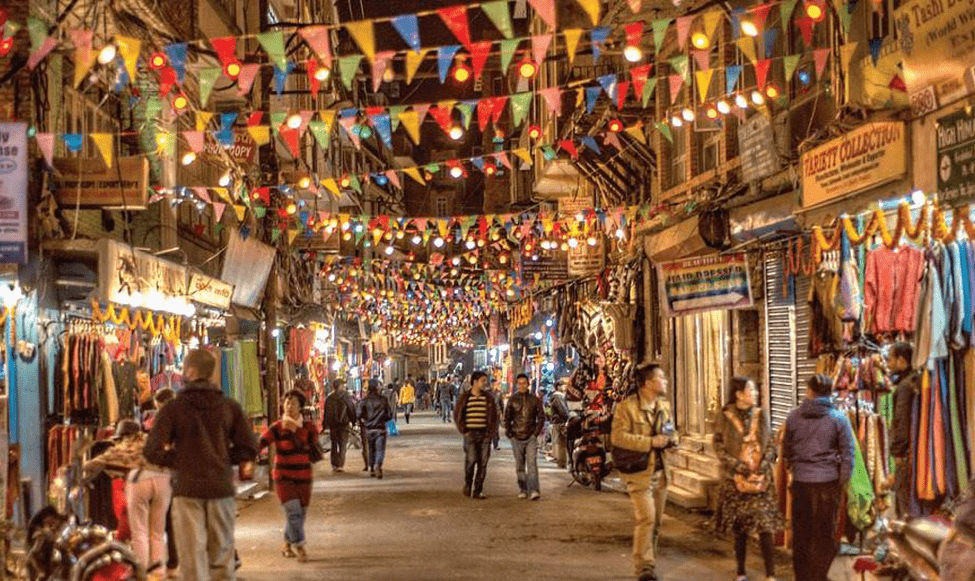
Thamel is a vibrant and bustling neighborhood in Kathmandu, known for its thriving tourist-oriented business. This part of the city has been a hotspot for tourism and local activity for more than four decades. Whether you’re in search of cultural experiences, lively pubs, cosy restaurants, or traditional temples, Thamel has something to offer.
Formerly referred to as Tabitha Bahal, Thamel is characterized by a maze of narrow streets lined with stalls and stores, each offering unique goods. While its popularity as a tourist destination might have raised prices somewhat, the products you can find in Thamel are truly unique. You’ll find everything from clothing, music albums, and trekking gear, to local produce and handmade goods.
The neighborhood is also packed with travel agencies, making it a convenient location for first-time visitors to the city or those who want to explore the wider region. Despite the pedestrian-filled streets, various modes of transport like cycle rickshaws, taxis, bicycles, and two-wheelers are still prevalent.
For food lovers, Thamel is a paradise. Its streets are filled with restaurants offering diverse cuisine, sure to please any food connoisseur. Street food vendors also offer a wide variety of fresh, local fare.
Thamel Bazaar, specifically, is the shopping heart of the Thamel neighborhood. Here, you can buy anything from fresh fruits and vegetables, pastries, handicrafts, and textiles, to souvenirs for friends and family back home.
After the sun sets, Thamel doesn’t slow down. It’s well-known for its nightlife, with many pubs, clubs, and music venues remaining open well past midnight. It is also home to many artists, adding to the vibrant cultural atmosphere.
Overall, a visit to Thamel offers a lively, culturally rich experience, a chance to buy unique goods, and an opportunity to sample some of the best food Kathmandu has to offer. Whether you’re visiting for the first time or are a seasoned traveler, Thamel is sure to provide a memorable experience.
10. Asan Bazar
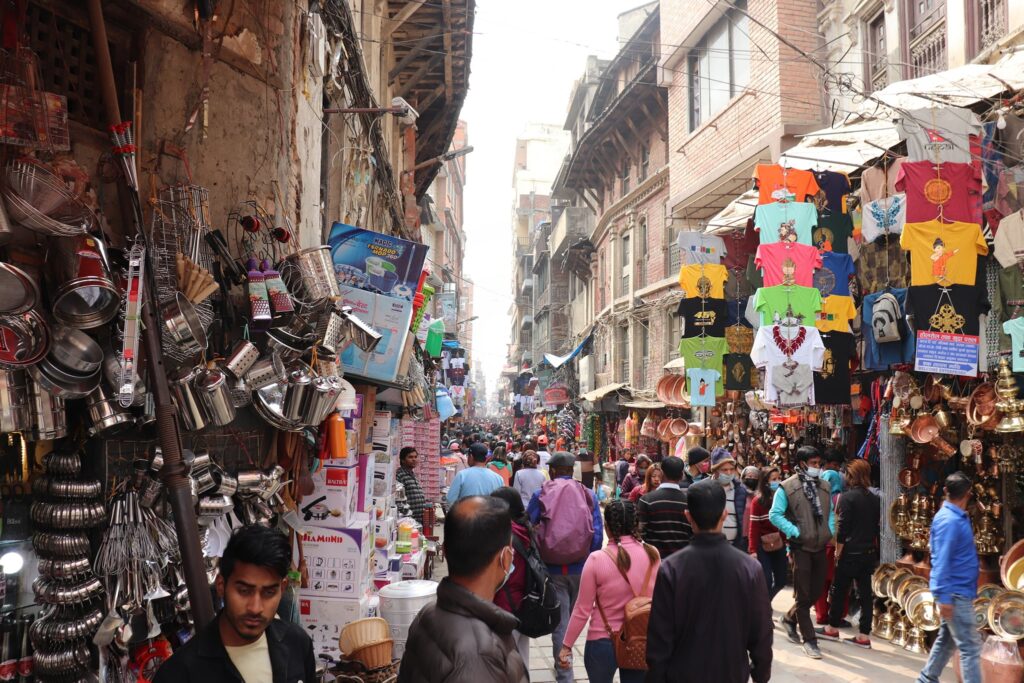
Don’t miss out on Asan Tole, Kathmandu’s bustling epicenter. This lively square brims with vendors peddling an assortment of goods, from fresh vegetables to aromatic spices and assorted foodstuffs. A haven for people-watchers, Asan Tole offers a genuine glimpse into the pulsating rhythm of Kathmandu’s daily life.
Home to the Annapurna Temple, Asan Tole is a nod to the goddess of abundance. The Narayan shrine, devoted to an incarnation of Vishnu, is another captivating sight to behold here.
On the other hand, the Thamel Neighborhood presents a different kind of allure. It elicits a spectrum of responses from its visitors – while first-timers often find themselves enamored by its vibrancy, others find its crowdedness a tad overwhelming. Regardless, Thamel is a goldmine for tourists, offering an array of attractive features such as excellent dining spots, a plethora of shops, thriving nightlife, a variety of hostels, and a centralized location.
My initial visit to Thamel left me feeling a bit swamped by the chaos of pedestrians, vehicular traffic, ongoing construction, and pollution. Also, encounters with men offering to sell drugs and sightings of inebriated tourists spilling out of bars after dark did little to alleviate my initial discomfort. Yet, despite its quirks, I believe Thamel is an excellent starting point for first-time visitors to Kathmandu. It is definitely worth exploring!
Recommended Read: Must visit places in Darjeeling
Average Weather in Kathmandu Nepal
| Month | Average High (°F) | Average Low (°F) | Average Rainfall (inches) |
|---|---|---|---|
| Jan | 34°F | 25°F | 1.6″ |
| Feb | 39°F | 27°F | 1.2″ |
| Mar | 52°F | 34°F | 1.6″ |
| Apr | 61°F | 41°F | 2.0″ |
| May | 70°F | 50°F | 3.1″ |
| Jun | 75°F | 55°F | 10.2″ |
| Jul | 81°F | 57°F | 15.7″ |
| Aug | 81°F | 57°F | 13.7″ |
| Sep | 73°F | 52°F | 11.4″ |
| Oct | 63°F | 43°F | 3.9″ |
| Nov | 46°F | 34°F | 0.8″ |
| Dec | 37°F | 28°F | 0.4″ |



